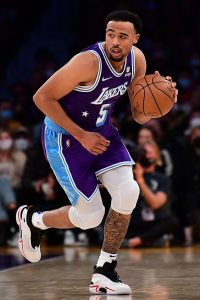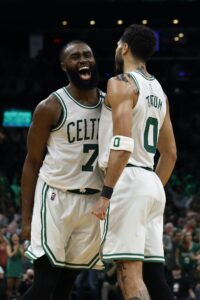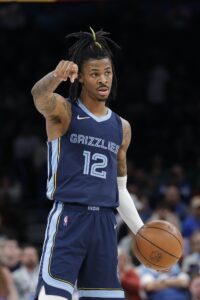Hoops Rumors is taking a closer look at each NBA team’s current roster situation, evaluating which clubs still have some moves to make and which ones seem most prepared for training camp to begin.
This series is meant to provide a snapshot of each team’s roster at this time, so these articles won’t be updated in the coming weeks as more signings, trades, and cuts are made. You can follow our roster counts page to keep tabs on teams’ open spots as opening night nears.
We’re wrapping up our pre-camp Roster Snapshot series today with the Northwest Division. Let’s dive in…
Denver Nuggets
- Players on guaranteed standard contracts: 15
- Players on Exhibit 10 contracts: 3
- Players on two-way contracts: 2
The Nuggets don’t really need to make any roster moves between now and the start of training camp. Their projected 15-man regular season roster looks set, as do their two-way slots — Gillespie suffered a major leg injury, but Denver reportedly intends to hang onto him as he recovers.
Minnesota Timberwolves
- Players on guaranteed standard contracts: 12
- Players on non-guaranteed standard contracts: 3
- Nathan Knight (partial guarantee), Jaylen Nowell, Austin Rivers (partial guarantee)
- Players on Exhibit 10 contracts: 2
- Players on two-way contracts: 2
- Players who have reportedly reached contract agreements: 1
- Phillip Wheeler (Exhibit 10)
Knight, Nowell, and Rivers look like pretty safe bets to join the 12 players with guaranteed salaries on the 15-man regular season roster, but that’s not set in stone yet. The partial guarantees owed to Rivers ($650K) and Knight ($350K) are modest enough that the Wolves could theoretically go in a different direction without being on the hook for much money.
Still, a player like Elleby or Garza would probably have to really impress Minnesota in training camp and the preseason in order to make the regular season squad.
Oklahoma City Thunder
- Players on guaranteed standard contracts: 17
- Players on non-guaranteed standard contracts: 1
- Vit Krejci (partial guarantee)
- Players on two-way contracts: 2
- Players who have reportedly reached contract agreements: 2
- Sacha Killeya-Jones (Exhibit 10), Jaden Shackelford (Exhibit 10)
With 17 players on guaranteed contracts and Krejci owed a $782K partial guarantee, the Thunder will have to trade or release at least three players on standard deals before opening night. Bazley, Favors, Jerome, Maledon, and Krejci are among those whose roster spots may not be 100% guaranteed quite yet.
Additionally, while Oklahoma City doesn’t have a two-way opening, it wouldn’t be a shock if the team makes a change to one of its two-way slots in the next month and a half. A player in the second year of a two-way contract, like Waters, often has a tenuous hold on his spot if he hasn’t yet proven himself as a rotation player.
Portland Trail Blazers
- Players on guaranteed standard contracts: 14
- Players on Exhibit 10 contracts: 2
- Players on two-way contracts: 1
- Players who have reportedly reached contract agreements: 2
- Devontae Cacok (Exhibit 10), Olivier Sarr (Exhibit 10)
Having moved out of luxury tax territory by a hair, the Trail Blazers are unlikely to fill their 15th roster spot, which would put them back in the tax. But they do still have a two-way spot to fill — Miller, Rhoden, Cacok, and Sarr would all be eligible to have their Exhibit 10 contracts converted into two-way deals, so there could be an open competition in camp.
Utah Jazz
- Players on guaranteed standard contracts: 17
- Players on two-way contracts: 2
- Players who have reportedly reached contract agreements: 4
- Paris Bass (Exhibit 10), Kofi Cockburn (Exhibit 10), Darryl Morsell (Exhibit 10), Jeenathan Williams (Exhibit 10)
Having acquired more players than they sent out in the Donovan Mitchell, Rudy Gobert, and Patrick Beverley trades, the Jazz now have a roster logjam to clear. They’ll have to trade or waive at least two more players with guaranteed contracts before the regular season tips off.
It’s hard to say at this point whose roster spots might be in danger, since there are still several trade candidates on Utah’s roster, including Beasley, Bogdanovic, Bolmaro, Clarkson, Conley, Gay, and Johnson. If multiple players from that group are on the move in the coming weeks, the issue may ultimately sort itself out (for instance, trading three players in exchange for Russell Westbrook and draft compensation would quickly clear the excess).
Previously:
 At 34 years old, Beverley is probably past his peak, but he’s certainly a short-term upgrade and a much better fit for the way the Lakers’ roster is constructed. He’s the exact type of guard who has typically thrived alongside James throughout his career, fitting the mold of a three-and-D player who doesn’t need the ball to be effective.
At 34 years old, Beverley is probably past his peak, but he’s certainly a short-term upgrade and a much better fit for the way the Lakers’ roster is constructed. He’s the exact type of guard who has typically thrived alongside James throughout his career, fitting the mold of a three-and-D player who doesn’t need the ball to be effective. Just because he was a poor fit with the Lakers doesn’t mean he lacks talent, and Horton-Tucker certainly has a chance to be a better player than Beverley ever was. The Jazz are betting that giving him a runway for a bigger role might bring out the best in him, allowing Utah to reap the long-term rewards.
Just because he was a poor fit with the Lakers doesn’t mean he lacks talent, and Horton-Tucker certainly has a chance to be a better player than Beverley ever was. The Jazz are betting that giving him a runway for a bigger role might bring out the best in him, allowing Utah to reap the long-term rewards. Brown has never made an All-NBA team, but he was an All-Star in 2021 and received All-NBA votes in 2022, so he could very well be in the mix in 2023.
Brown has never made an All-NBA team, but he was an All-Star in 2021 and received All-NBA votes in 2022, so he could very well be in the mix in 2023.